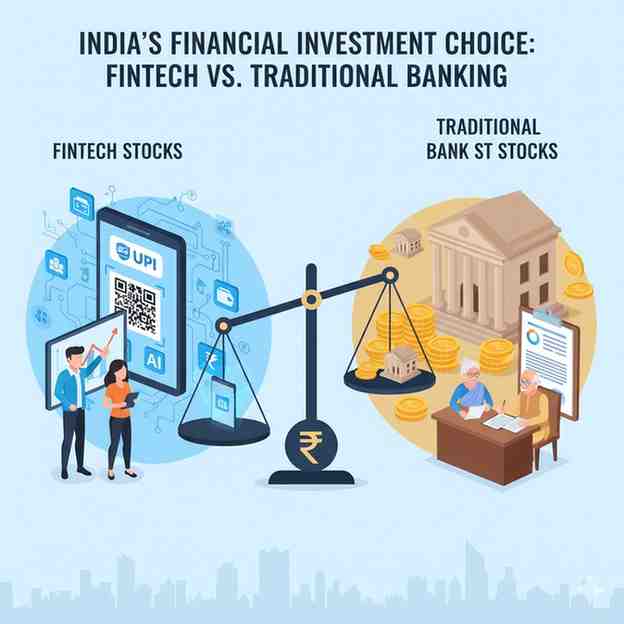
Fintech Stocks vs. Traditional Bank Stocks: Key Differences for Investors
Fintech Stocks vs. Traditional Bank Stocks: Key Differences for Investors
India’s financial landscape is rapidly evolving. With the rise of digital innovation, fintech companies have redefined how people access, borrow, and invest money. At the same time, traditional banks continue to play a vital role in the economy, offering stability, trust, and regulatory confidence.
Thank you for reading this post, don't forget to subscribe!For investors, understanding the key differences between fintech and banking sector investments is essential to make informed portfolio decisions. This article explores how fintech stocks vs. traditional bank stocks in India differ in terms of growth potential, risk, valuation, and long-term opportunities.
Fintech Stocks vs. Traditional Bank Stocks in India: Understanding the Investment Landscape
The Indian financial sector is among the most dynamic in Asia, driven by digitization, regulatory reforms, and an expanding middle class.
While traditional banks dominate the formal lending and deposit market, fintech companies are capturing new-age consumers through technology-driven services such as:
- Digital payments (UPI, wallets)
- Online lending and BNPL (Buy Now, Pay Later)
- Wealth management and robo-advisory
- Insurtech and digital credit scoring
Fintech companies listed in Indian markets, or those backed by public and private investors, are seen as agile players capable of scaling quickly with lower physical infrastructure costs. Conversely, banking stocks remain favored for their consistent earnings, dividend potential, and established customer base.
Key Differences Between Fintech and Banking Sector Investments for Indian Investors
- Business Model and Revenue Generation
- Traditional Banks:
Banks earn mainly through interest income on loans, fees on deposits, and transaction services. Their business model depends on managing credit risk and maintaining adequate reserves as per RBI norms. - Fintech Companies:
Fintech firms generate revenue through digital transaction fees, subscription models, data analytics, and partnerships with banks or NBFCs. Their strength lies in scalability and innovative product design rather than capital-heavy operations.
Investor takeaway: Fintech companies focus on rapid growth and technology adoption, while banks prioritize steady income and balance sheet strength.
2. Regulation and Risk Exposure
- Banks operate under stringent RBI regulations, capital adequacy requirements, and strict compliance norms, offering a sense of security to investors.
- Fintech firms, though regulated, enjoy relatively flexible frameworks that allow faster innovation — but also expose them to regulatory uncertainty.
Investor takeaway: Traditional bank stocks provide stability in policy-driven environments, whereas fintech stocks carry higher risk but greater innovation potential.
3. Technology and Innovation
How fintech companies are transforming India’s financial services industry is one of the most visible changes in the market.
Digital-first platforms like Paytm, Policybazaar, and Zaggle Prepaid Ocean Services leverage AI, machine learning, and blockchain to improve user experience and expand financial inclusion.
Traditional banks, in contrast, are adapting by adopting fintech capabilities — through mobile apps, digital onboarding, and partnerships with tech startups. Many large banks, such as HDFC Bank and ICICI Bank, have also invested in fintech collaborations to stay competitive.
Investor takeaway: Fintech firms are technology leaders, but banks with strong digital transformation strategies can also offer sustainable hybrid growth.
4. Profitability and Valuation
The investment opportunities in fintech and banking stocks differ significantly when viewed through profitability and valuation metrics:
- Fintech stocks often trade at higher price-to-sales (P/S) or price-to-book (P/B) ratios due to future growth expectations. However, many remain in expansion mode and may not yet be consistently profitable.
- Banking stocks, on the other hand, offer predictable earnings, steady dividends, and lower volatility. Their valuation is often benchmarked on metrics such as net interest margin (NIM), asset quality, and return on equity (ROE).
Investor takeaway: Fintech offers higher growth potential with greater volatility, while traditional banks offer consistent returns backed by strong fundamentals.
5. Market Sentiment and Growth Prospects
Market sentiment plays a key role in shaping fintech vs banking sector stocks performance.
- The fintech sector benefits from the rapid expansion of digital payments, UPI adoption, and online lending, which continue to accelerate post-pandemic.
- The banking sector, meanwhile, benefits from credit demand recovery, infrastructure investments, and regulatory stability.
With India’s fintech ecosystem projected to exceed USD 150 billion by 2025, investors are looking to balance high-growth fintech exposure with the steady returns of traditional banking stocks.
Investment Opportunities in Fintech and Banking Stocks: Which Offers Better Growth Potential?
For Indian investors, the choice between fintech and banking stocks depends on risk tolerance, investment horizon, and market outlook:
- Aggressive investors may prefer fintech companies that offer scalability, innovation, and potential for exponential growth as digital adoption deepens.
- Conservative investors may continue favoring established banks with proven profitability and dividend history.
- Balanced portfolios can include both — capturing fintech’s innovation-led upside while maintaining stability through traditional bank exposure.
In fact, many mutual funds and ETFs are now structuring hybrid financial sector portfolios combining both fintech and bank holdings to balance risk and reward.
Comparing Fintech and Traditional Bank Stocks: What Indian Investors Should Know Before Investing
Before investing in this space, investors should consider the following:
- Regulatory Evolution: Monitor RBI and SEBI frameworks for digital lending, KYC norms, and cybersecurity standards.
- Earnings Visibility: Analyze cash flows and profitability metrics, especially for early-stage fintech firms.
- Technology Risk: Assess how well companies adapt to new technologies and data protection norms.
- Market Share and Partnerships: Evaluate whether fintechs are collaborating with established banks or competing directly.
- Valuation Discipline: Avoid overpaying for growth expectations in fintech without clear earnings potential.
A diversified approach — combining the innovation of fintech and the resilience of traditional banks — can help investors benefit from India’s evolving financial ecosystem.
Conclusion
Both fintech and traditional banking stocks play distinct yet complementary roles in India’s financial markets.
Fintech companies bring agility, innovation, and growth potential, while banks contribute stability, regulation, and scale.
As India continues its journey toward a digitally empowered financial system, investors who understand the key differences between fintech and banking sector investments can strategically position their portfolios for balanced, long-term growth.
Ultimately, the most effective strategy may not be “fintech vs. banks,” but rather “fintech with banks” — where innovation and trust together shape the future of financial investing in India.
Related Blogs:
How UPI Growth Influences Fintech Companies Listed in Indian Markets
How Digital Lending Is Driving Demand for Fintech Stocks in India
Portfolio Diversification with Fintech Stocks in India: What Investors Should Know
Top NBFC Non-Banking Financial Companies Stocks to Invest in India for 2025
Invest in the Future: Top Small-Cap Bank Stocks in India for 2025
Top 5 Fintech Stocks in India
What Makes a Small-Cap Bank Stock a Good Investment?
Understanding Small-Cap Bank Fundamentals: A Guide for Indian Investors
How Digitalization is Transforming Small-Cap Banking in India
Top 5 Finance Stocks in India
Disclaimer: This blog post is intended for informational purposes only and should not be considered financial advice. The financial data presented is subject to change over time, and the securities mentioned are examples only and do not constitute investment recommendations. Always conduct thorough research and consult with a qualified financial advisor before making any investment decisions.

